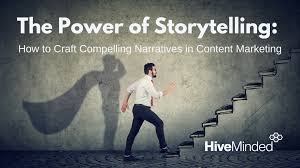In today’s fast-paced digital world, businesses are constantly seeking ways to stand out and connect with their audiences. The key to building meaningful relationships with potential customers is storytelling. Through the art of storytelling, brands can craft content that not only informs but also engages, resonates, and builds trust. This form of content marketing has evolved as one of the most effective ways to communicate your brand’s message, drive traffic, and ultimately, increase conversions. But how exactly can you leverage storytelling in your content marketing strategy? Let’s dive into the power of storytelling and explore how to craft compelling content that truly connects with your audience.
Understanding the Role of Storytelling in Content Marketing
Storytelling isn’t just a buzzword in the world of content marketing; it’s an essential component that helps your brand resonate with consumers on a deeper level. When you tell a story, you’re not merely sharing information, but creating an experience that your audience can relate to. This emotional connection fosters trust and encourages people to engage with your brand. It’s no longer enough to simply share facts and features of your product or service. Today’s consumers want to hear about the real people, challenges, and successes that come with using your brand.
Content marketing has shifted from traditional advertising tactics to more narrative-driven approaches. Brands are increasingly telling stories that highlight their values, culture, and customer experiences. For instance, storytelling allows you to humanize your business, showing the people behind the logo. It invites customers to see your company as not just a business but as a solution to their problems, a part of their journey, and someone they can rely on.
The Elements of a Great Story in Content Marketing
To effectively use storytelling in content marketing, there are key elements that make a story compelling and relatable. Every good story follows a structure, and applying this to your content will make it more engaging.
1. A Strong Beginning: Hooking Your Audience
The opening of your story is crucial. Just like any good novel or movie, the beginning sets the tone and hooks the reader’s attention. In content marketing, your headline and introduction should spark curiosity and invite the reader to dive deeper into the content. Start with a question, a bold statement, or an intriguing scenario that aligns with your target audience’s interests or pain points.
2. A Central Conflict or Challenge
Every story needs conflict to keep the audience engaged. In content marketing, this conflict can be the problem that your product or service solves. It’s important to identify the challenges your target audience faces and explain how your brand can help. The struggle could be anything from saving time, improving productivity, or solving a particular issue related to their lifestyle or business. Highlighting this conflict adds depth to the story and shows why your solution is relevant.
3. The Resolution: How Your Brand Solves the Problem
The resolution is where the magic happens. Once the conflict is established, you want to show how your brand steps in to solve the problem. This is where your product or service becomes the hero of the story. But don’t just stop at the solution—demonstrate how it brings real value to the customer. Share testimonials, case studies, or real-life examples that showcase how your brand has positively impacted others. This step not only reinforces the effectiveness of your offering but also builds credibility and trust with your audience.
Crafting Compelling Content that Resonates with Your Audience

Once you understand the key elements of a compelling story, it’s time to translate them into your content. Here are some tips for creating storytelling-driven content marketing that resonates with your audience:
1. Know Your Audience
Before you can craft a compelling story, you need to understand who you’re telling it to. Conduct audience research to learn about their needs, preferences, pain points, and desires. This will allow you to create content that speaks directly to them. Whether you’re creating a blog post, video, or social media content, tailoring the story to your audience will make it more impactful.
2. Be Authentic and Transparent
Authenticity is key in today’s content marketing landscape. Audiences can quickly spot disingenuous or overly promotional content. When sharing your brand story, be honest about both the challenges and successes. This transparency will help build trust and make your content more relatable. People want to connect with brands that are real, not perfect.
3. Use Emotion to Engage Your Audience
One of the most powerful aspects of storytelling is its ability to evoke emotion. Whether it’s excitement, empathy, or joy, emotional connections drive people to take action. When creating your content, think about how you want your audience to feel. Do you want them to feel inspired? Motivated to try your product? Or perhaps reassured that they’re making the right choice? Emotions drive decision-making, and connecting with your audience emotionally will increase the likelihood of conversions.
Using Content Marketing to Boost Engagement and Conversions
Now that we understand how storytelling can create more compelling content, let’s talk about how it can enhance your overall content marketing strategy.
1. Build Brand Awareness
Through storytelling, you can introduce your brand to a wider audience. Stories are shareable, and when your content resonates with people, they’re more likely to share it within their own networks. This amplification leads to more exposure for your brand and an increase in organic traffic.
2. Enhance Customer Loyalty
When you craft content that connects with your audience, it builds loyalty. Customers who resonate with your story are more likely to stick around. You can build long-lasting relationships by consistently providing valuable content that speaks to their needs and aspirations.
3. Drive Sales and Conversions
At the end of the day, the goal of content marketing is to convert leads into customers. When storytelling is done right, it drives people to take action. Whether it’s signing up for your newsletter, requesting a demo, or making a purchase, compelling content is a powerful tool in driving conversions.
Conclusion: The Power of Storytelling in Content Marketing
Incorporating storytelling into your content marketing strategy is no longer optional—it’s essential. By creating narratives that are relatable, engaging, and valuable, you can foster deeper connections with your audience. Not only does storytelling enhance brand awareness and customer loyalty, but it also drives higher engagement and conversions. When you tell a story that resonates with your target audience, you’re not just creating content—you’re building a relationship. Embrace storytelling in your content marketing efforts, and watch your brand grow.
Final Thoughts: Embrace the Art of Storytelling in Your Content Marketing Strategy
As you embark on your content marketing journey, remember that storytelling is an invaluable tool for driving success. Take the time to craft meaningful, authentic stories that connect with your audience on a deeper level. By weaving narratives that address their pain points and provide solutions, you’ll create content that not only informs but inspires. Storytelling has the power to transform your content marketing strategy and take your brand to new heights.


